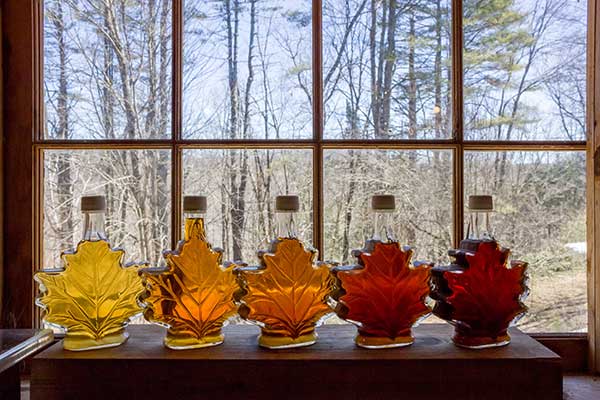What is the history of maple syrup production in Ontario?
Read on to find out!
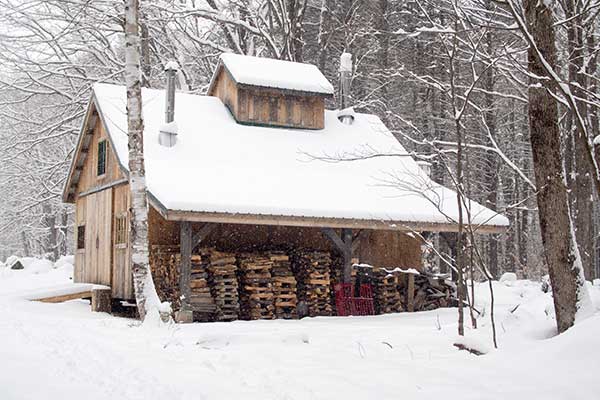
Nothing says spring in Ontario like the maple harvest. Like the melting of snow, the first crocuses poking their heads above ground, and the singing of early returning robins, it’s a sure sign that the seasons are changing.
The harvesting of sap from red and silver sugar maple trees to produce sweet, delicious syrup is a beloved tradition in rural Ontario. And for many of us, spring wouldn’t be spring without experiencing the sweetness of maple season in some manner – a tour of a sugar bush, delightful maple-inspired dishes, a family-friendly festival celebrating the season.
Mother Nature dictates the timing of maple season. For sap to flow, the sugarbush must be in a midst of a freeze/thaw cycle where temperatures are below freezing at night but warm to above freezing during the day. The freezing temperatures at night cause negative pressure in the tree. Essentially, the tree turns into a vacuum so that it sucks up water from the roots. On its way in, that water gathers sugars stored in the tree. During the day, warmer temperatures create positive pressure that pushes the water, now sap, down to the bottom of the tree. This is what they mean when they say the sap is running.
When does maple sap run?
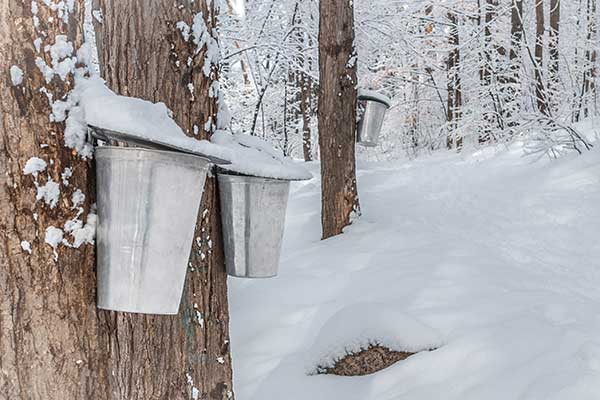
This perfect confluence of environmental conditions typically lasts about four-six weeks, in Ontario generally from early March to late mid-April (depending on the region).
Of course, collecting maple sap for sugar was not the invention of European settlers. Woodland First Nations had been practising it for centuries before the first white man even appeared on the shores of the New World. Some historians have postulated that at some point in the distant past First Nations people, in a desperate attempt to ward off starvation after a harsh winter, began cutting bark off maple trees to reach the cambium, the edible part between the hardwood and bark. Cuts that went too deep, penetrating the hardwood, produced leaking sap that was surprisingly sweet. And thus, maple water was discovered. First Nations peoples each have their own distinct lore as to what led to the discovery.
When was maple first used in Ontario?
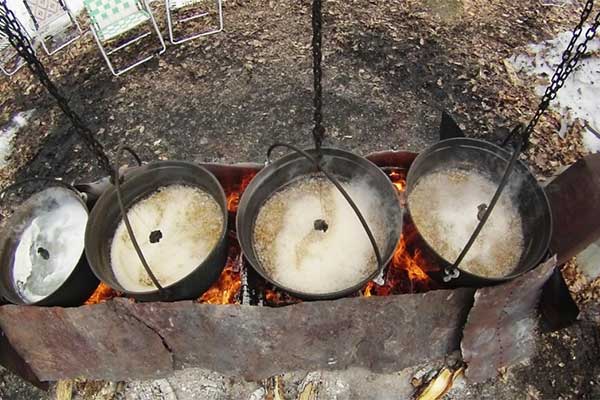
Whatever manner by which it was discovered, maple sap became an important part of First Nations life. They drank it as a fortifying tonic – modern studies have confirmed what they long knew; that maple sap served as an antioxidant and anti-inflammatory. They also would have used it to cook – Bannock, a sort of unleavened bread used as a provision on long journeys, was made from corn flour, bear fat, and maple sugar.
First Nations’ methods of making maple sugar were relatively crude by modern standards, but ingenious, nonetheless. Blades were used to gash a maple tree in a slanted direction, cutting through the bark into the wood beneath. Into this wound was inserted a wooden chip along which the leaking sap would run, eventually dripping into birch pails or into hollowed out logs resting on the ground below. The sap was then boiled down in earthenware pots over a fire or by adding red-hot stones into a sap-filled a trough.
Experience the maple season through a First Nations lens at the Wye Marsh Sweetwater Festival, held jointly at Wye Marsh and Sainte-Marie among the Hurons. Enjoy Indigenous storytelling, roast bannock on a stick, watch historical demonstrations, and learn how the Huron-Wendat traditionally welcomed spring.
Early European settlers, first in Quebec, as early as the 17th century, and then in Ontario learned from First Nations the value of tapping maple trees. The settler methodology of making maple sugar was on a far larger scale than that practised by First Nations people, but at first largely similar. Gashes were made into trees and a round wooden spout was inserted an inch into the wood. Pails were placed below to collect the dripping sap. The collected sap was then boiled down in large iron or copper kettles.
The 19th century saw an evolution in maple syrup harvesting. In the 1870s, metal taps began to take the place of wood. Then, in 1889, the evaporator was invented and patented in the United States. The evaporator represented a significant investment, so while harvesters on a commercial scale quickly adopted them kettles remained in use by small-scale producers well into the 20th century.
Harvesting maple sap was an important yearly rite in rural Ontario, an example of typical pioneer ingenuity in using local resources to provide for one’s needs. Unlike today, comparatively little maple syrup was produced; instead, settlers used the sap for manufacturing maple sugar. At the time cane sugar, what we commonly call white sugar, was expensive because it had to be imported from the Caribbean. Maple sugar, painstakingly manufactured from the sweet springtime sap of maple trees, was an ideal substitute.
Additionally, settlers used sap to create maple butter. The name of this product is a bit of a misnomer. There’s no dairy whatsoever in maple butter. Instead, it’s maple syrup that is heated to 100 degrees, quickly cooled, and then whipped into a smooth spread that would be added to cakes or put on bread.
Harvesting maple sap was time consuming and tiring. Consider that it takes 50 gallons of sap to make just 1 gallon of syrup, and that it takes two or three trees to produce that quantity of sap over the course of an entire season, and you begin to get an idea of how many trees had to be tapped. The bush might be covered in wet, heavy snow, and where it wasn’t the ground would be soft mud – in either event, you returned home at the end of the day wet and exhausted. And then you headed out again the next day.
As the 20th century dawned, sugar was becoming cheaper and more readily available throughout Ontario. The harvesting of maple sap became rarer, and those who continued did so with an eye largely towards supplying the growing demand for maple syrup rather than for sugar.
Modern-Day Maple Syrup Production
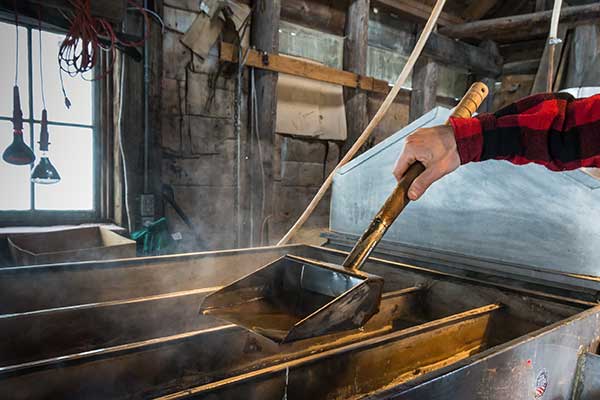
Modern methods of harvesting sap are far removed from the days of manually emptying buckets. Today, food grade tubing stretch through the woods, connecting hundreds of trees to the sugarhouse. Aided by a vacuum pump, sap runs through the tubes to the storage tanks in the sugarhouse. Once enough sap has been collected it is pumped to a reverse osmosis machine that concentrates all the sap by removing approximately 75-80 % of the excess water. When enough concentrate has been collected, the sap moves to the evaporator to be turned into syrup. Ontario Maple regulations state the density of maple syrup must be a minimum of 66% sugar. Once the correct sugar density is reached the syrup is ready to be filtered and then packaged.
Experience the methods behind the harvest for yourself with the Yours Outdoors Maple Magic program – pancakes included!
Celebrating Maple Season in Ontario
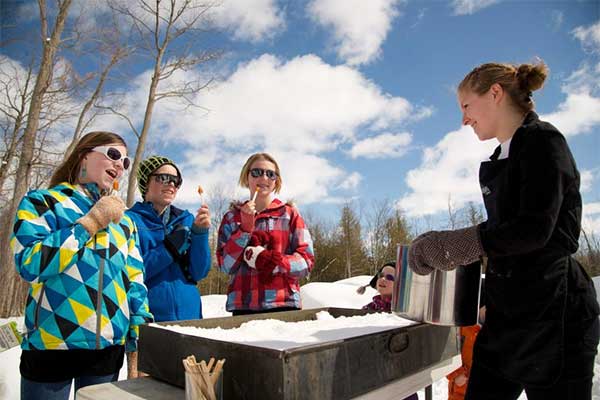
In Ontario, hundreds of producers continue to embrace maple season today. Maple syrup is produced commercially wherever maples are found, from the southern tip of the province to Thunder Bay in the northwest. With a production level of close to a million litres per year, Ontario is the second largest producer of maple syrup in the country next to Quebec. Maple is generally considered to be the first agricultural crop of the year.
Many farms open their sugar bushes for tours and other sweet experiences. Among them is Windlee Farms near Midland, a family-operated business which taps 500 trees and has an onsite store.
‘Sugar bush season’ has been increasingly popular. And why not? It is a great way to shake off winter and embrace spring, to get out into nature, and to enjoying local, sustainable agriculture. And while a tour of a sugar bush may be a highlight, there are many more experiences to enjoy – maple-themed dining, soothing maple spa treatments, savoring maple themed beer, shopping in quaint shops for maple candles and other novelty items, and more.
Setting aside a day or weekend to make your own maple memories has never been easier. Orillia and Lake Country Tourism hosts an annual Tap into Maple program, running March 3 to April 2 (2024) with 20 participating locations. Muskoka has a similar tour, the Muskoka Maple Trail, culminating in the Muskoka Maple Festival in Huntsville on April 27 (2024).
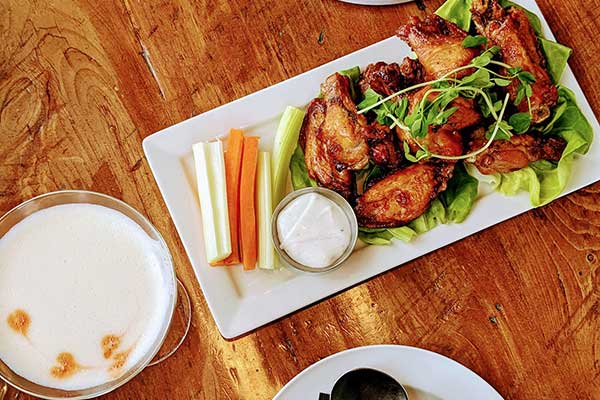
You’ll need a place to rest your head if you plan to make a weekend of your adventures. There are plenty of resorts in the region that embrace the maple season. In addition to warm hospitality, Bayview Wildwood Resort, Sherwood Inn, and Christie’s Mill Inn and Spa all offer maple-themed dining. All three are charming, tranquil, and historic – a recipe for a memorable stay.
The culinary team at JW Marriott The Rosseau Muskoka Resort likewise creates sweet dishes, but this resort also offers maple experiences of their own. JW Marriott The Rosseau offers maple-infused spa treatments at its award-winning HydroSpa Muskoka, maple campfire treats, and a sugar-tent where you can learn about the history of maple syrup production.
Maple sap runs for only a brief window, and so too does the opportunity to savour the bounty of the springtime forest at one Ontario’s varied maple farms and maple experiences.
Article written by Andrew Hind.

